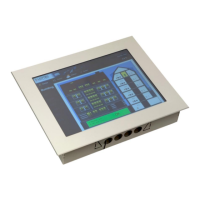L-VIS User Manual 184 LOYTEC
Version 6.2 LOYTEC electronics GmbH
has a slot for each input and output, which can be connected to the respective data points as
depicted in Figure 5 (b). For this multi-slot connection the math block adapter defines a
fixed layout of the slots; no more slots can be added to this connection.
In a math block adapter with n inputs v
1
, v
2
, … , v
n
each output o
i
is calculated as a formula
depending on all inputs o
i
= f
i
(v
1
, v
2
, … , v
n
). Each output has two math formulae following
the same format as used in math objects (see Section 9.13):
Output value formula: This formula calculates the output value as a function of
all input values.
Output enable formula: This formula calculates an output enable (result > 0 is
enable) for the output. If the output is enabled, the output value will be written to
the output. If the output is disabled, the calculated output value is not written to
the output.
In addition, each input slot can be configured whether it shall trigger the calculation or not.
Normally, any change in any input triggers the calculation of all outputs.
10.2.3 Global Connections
Global connections provide the same notions as local connections but extend beyond the
scope of one device. A global connection establishes a data cloud with a system-wide
name. Data points added to a global connection can send data into that connection or
receive data from the connection. The data is transferred over an IP-based network. All data
is automatically matched by the global connection name. This makes global connections
especially useful to provide certain global data in a system, without knowing who will be
reading that data. Examples are weather station data, wind alarms or global on/off.
Global connections cannot use adapters for conversions as done in local connections. If
conversions are needed, an intermediate register data point must be used to receive/send
data from/to the global connection. The adapter needs to be installed with a local
connection between the register and the data point, which requires the conversion.
The system in which the data cloud of a global connection is established is defined by an
IP-852 channel. This channel is not related to the CEA-709 technology; it is purely used to
define the set of devices exchanging data through global connections. It can, however,
coexist with an IP-852 channel for CEA-709. The configuration of the IP-852 channel is
done by adding all devices taking part in data exchange via global connections to a
configuration server.
A global connection has the following properties:
Max Send Time: This timing parameter of the global connection specifies a time
in seconds, in which a value update is transmitted into the connection, even if not
value has changed. This is typically used for heartbeat functions.
Min Send Time: This timing parameter of the global connection specifies a time
in seconds, for which transmissions will be delayed after sending out a value into
the connection. This setting can be used to limit the transmission rate to the
connection.
The following properties are derived from the data points in a global connection:
Receive Timeout: A data point with a receive timeout will be put into the state
offline, if it does not receive a value within the specified period of time (see
Section 10.1.2). This also applies to values received from the global connection.
Poll on startup: If a data point in the global connection has the poll on startup
feature enabled (see Section 10.1.2), an initial value update will be triggered for
the global connection.

